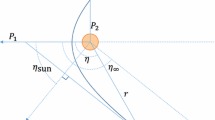Abstract
This study provides a single-point position estimation technique for interplanetary missions by observing visible planets using star trackers. Closed-form least-squares solution is obtained by minimizing the sum of the expected object-space squared distance errors. A weighted least-squares solution is provided by an iterative procedure. The weights are evaluated using the distances to the planets estimated by the least-squares solution. It is shown that the weighted approach only requires one iteration to converge and results in significant accuracy gains compared to simple least squares approach. The light-time correction is taken into account while the star-light aberration cannot be implemented in single-point estimation as it requires knowledge of the observer velocity. The proposed method is numerically validated through a statistical scenario as follows. A three-dimensional grid of test cases is generated: two dimensions sweep through the ecliptic plane and the third dimension sweeps through time from January 1, 2018 to January 1, 2043 in 5-year increments. The observer position is estimated at each test case and the estimate error is recorded. The results obtained show that a large majority of positions are well suited to position estimation by using star trackers pointing to visible planets, and reliable and accurate single-point position estimations can be provided in interplanetary missions. The proposed approach is suitable to be used to initiate a filtering technique to increase the estimation accuracy.











Similar content being viewed by others
Notes
The measurement additive model provided in Eq. (13) is valid for small errors, only. It is correct for unconstrained vectors. Unfortunately, attitude measurements (observed directions) are constrained to unit-norms. For this reason, as the error grows, the additive model becomes less and less accurate. In these cases, the correct multiplicative error (Mortari and Majji 2009) must be adopted.
To give an idea on how large is this deviation, just by considering the Earth velocity (about 30 km/s), the maximum star-light aberration is \(20^{\prime \prime }\) for stars normal to the ecliptic plane.
References
Conway, D., Mortari, D.: Single-point and Filtered Relative Position Estimation for Visual Docking. In: International Conference on Computational & Experimental Engineering and Sciences (ICCES), Reno, NV, July 20–24, (2015)
Flewelling, B., Mortari, D.: Information theoretic weighting for robust star centroiding. J. Astronaut. Sci. 58, 241–259 (2010)
Karimi, R.R.: Designing an Interplanetary Autonomous Spacecraft Navigation System using Visible Planets. PhD thesis, Texas A&M University, May (2012)
Karimi, R.R., Mortari, D.: Autonomous interplanetary navigation system using visible planets. J. Guid. Control Dyn. 38, 1151–1156 (2015)
Lu, C.-P., Hager, G.D., Mjolsness, E.: Fast and globally convergent pose estimation from video images. IEEE Trans. Pattern Anal. Mach. Intell. 22(6), 610–622 (2000)
Markley, F.L., Mortari, D.: Quaternion attitude estimation using vector observations. J. Astronaut. Sci. 48, 359–380 (2000)
Mortari, D.: Second estimator of the optimal quaternion. J. Guid. Control Dyn. 23, 885–888 (2000)
Mortari, D., Majji, M.: Multiplicative measurement model. J. Astronaut. Sci. 57, 47–60 (2009)
Mortari, D., Markley, F.L., Singla, P.: Optimal linear attitude determination. J. Guid. Control Dyn. 30(6), 1619–1627 (2007)
Mortari, D., Bruccoleri, C., La Rosa, S., Junkins, J.L.: CCD Data Processing Improvements. In: International Conference on Dynamics and Control of Systems and Structures in Space 2002, King College, Cambridge, England, July 14–18 (2002)
Mortari, D., Samaan, M.A., Bruccoleri, C., Junkins, J.L.: The pyramid star identification technique. Navigation 51, 171–183 (2004)
Samaan, M.A., Mortari, D., Pollock, T.C., Junkins, J.L.: Predictive Centroiding for Single and Multiple FOVs Star Trackers. Paper AAS 02-103, AAS/AIAA Space Flight Mechanics Meeting, San Antonio, TX, January 27–31, (2002)
Sheikh, S.I., Pines, D.J.: Recursive estimation of spacecraft position and velocity using X-ray pulsar time of arrival measurements. Navigation 53(3), 149–166 (2006)
Sheikh, S.I., et al.: Spacecraft navigation using X-ray pulsars. J. Guid. Control Dyn. 29(1), 49–63 (2006)
Author information
Authors and Affiliations
Corresponding author
Rights and permissions
About this article
Cite this article
Mortari, D., Conway, D. Single-point position estimation in interplanetary trajectories using star trackers. Celest Mech Dyn Astr 128, 115–130 (2017). https://doi.org/10.1007/s10569-016-9738-4
Received:
Revised:
Accepted:
Published:
Issue Date:
DOI: https://doi.org/10.1007/s10569-016-9738-4




